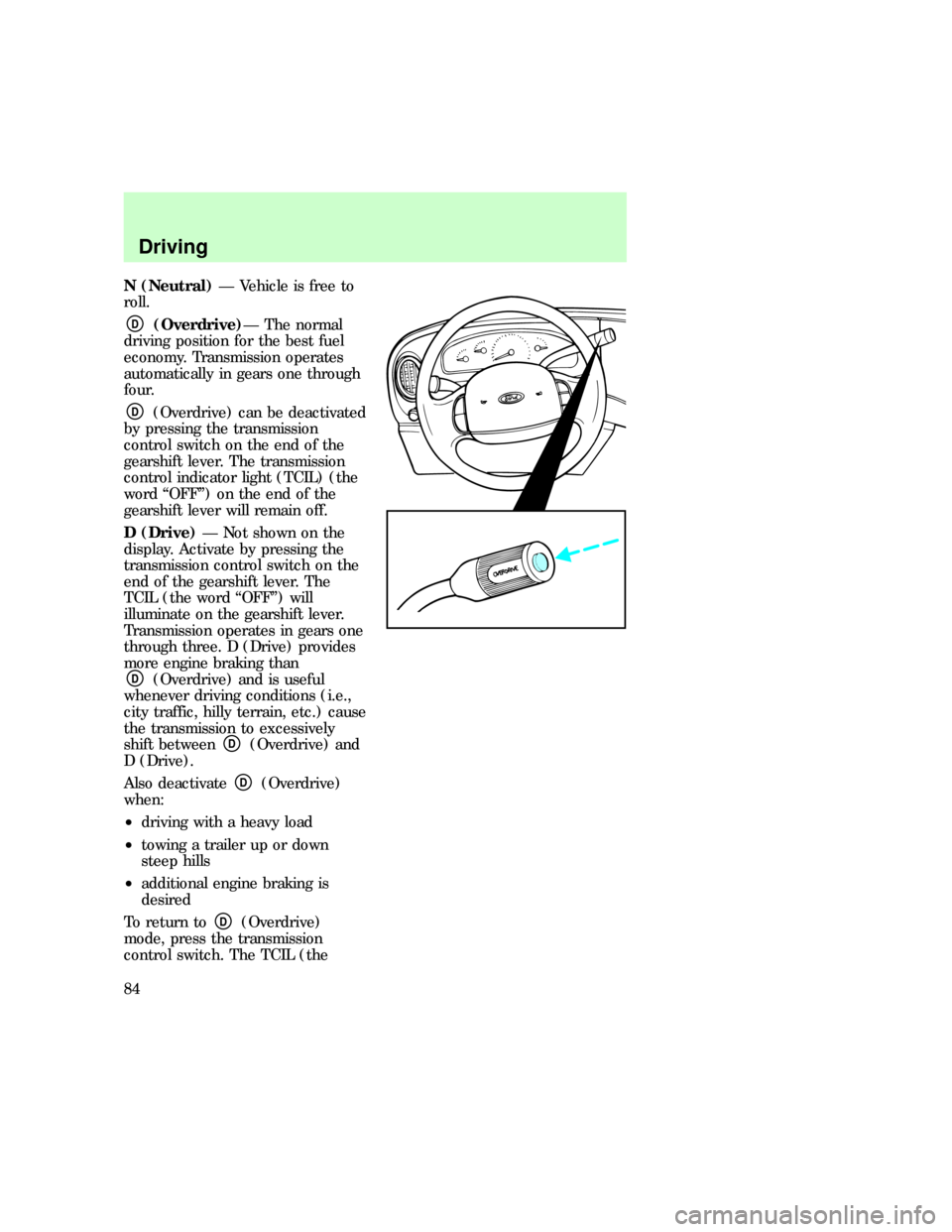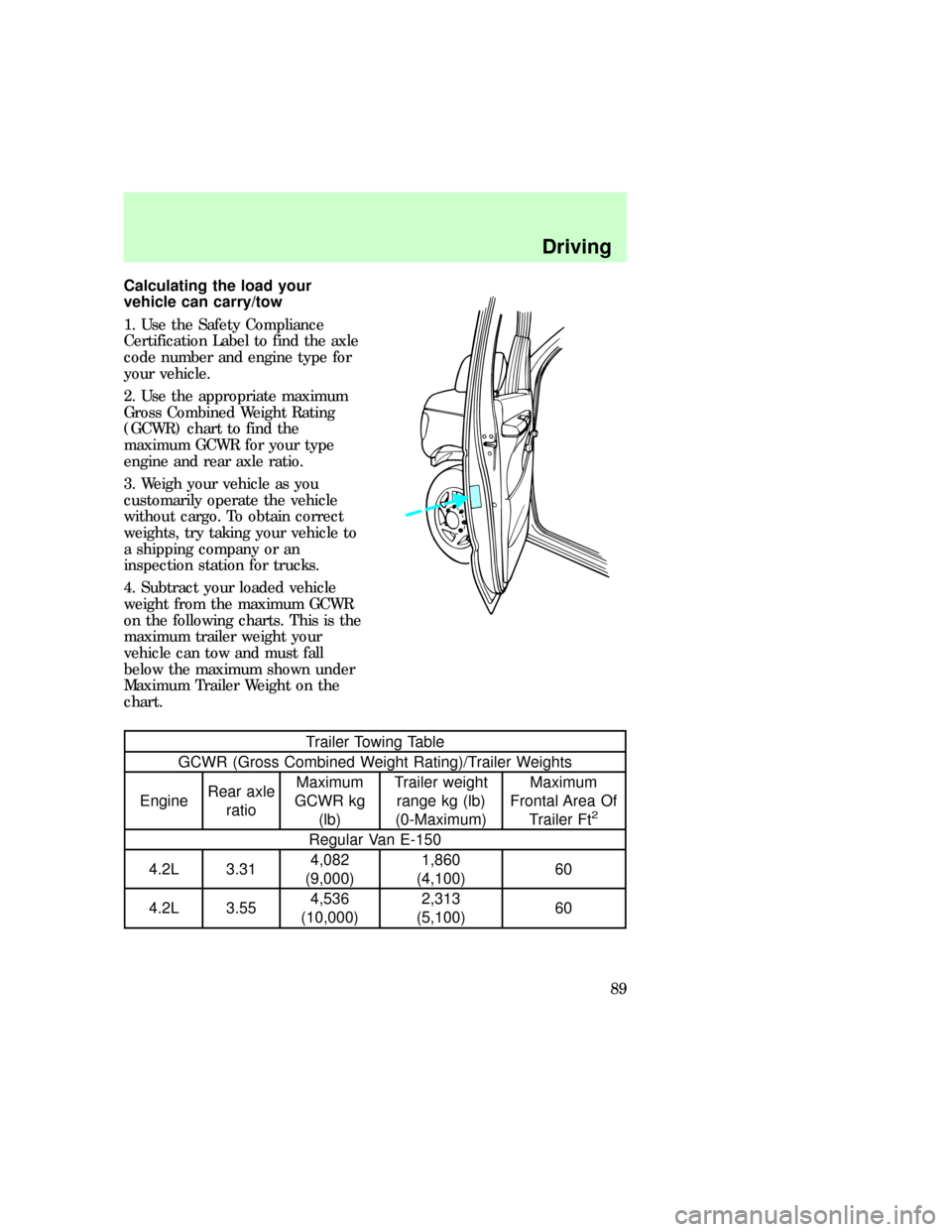Page 83 of 192
steering wheel seem to be in a
different position while going
straight down the road, have the
suspension and steering checked
for possible damage.
AUTOMATIC TRANSMISSION
OPERATION
Hold the brake pedal down
while you move the
gearshift lever from position to
position. If you do not hold the
brake pedal down, your vehicle
may move unexpectedly and
injure someone.
Pull the gearshift lever towards
you and downward to move the
automatic gearshift.
P (Park)Ð Always come to a
complete stop before shifting into
or out of P (Park).
When you leave your
vehicle, place the gearshift
lever in P (Park). Set the
parking brake fully, and shut off
the engine. Never park your
vehicle in N (Neutral). If you do
not take these precautions, your
vehicle may move suddenly and
injure someone.
R (Reverse)Ð Always come to a
complete stop before shifting into
or out of R (Reverse).
P RN 21D
P RN 21D
eco_automatic_trans
Driving
83
Page 84 of 192

N (Neutral)Ð Vehicle is free to
roll.
D(Overdrive)Ð The normal
driving position for the best fuel
economy. Transmission operates
automatically in gears one through
four.
D(Overdrive) can be deactivated
by pressing the transmission
control switch on the end of the
gearshift lever. The transmission
control indicator light (TCIL) (the
word ªOFFº) on the end of the
gearshift lever will remain off.
D (Drive)Ð Not shown on the
display. Activate by pressing the
transmission control switch on the
end of the gearshift lever. The
TCIL (the word ªOFFº) will
illuminate on the gearshift lever.
Transmission operates in gears one
through three. D (Drive) provides
more engine braking than
D(Overdrive) and is useful
whenever driving conditions (i.e.,
city traffic, hilly terrain, etc.) cause
the transmission to excessively
shift between
D(Overdrive) and
D (Drive).
Also deactivate
D(Overdrive)
when:
²driving with a heavy load
²towing a trailer up or down
steep hills
²additional engine braking is
desired
To return to
D(Overdrive)
mode, press the transmission
control switch. The TCIL (the
Driving
84
Page 87 of 192

²Payload:Combined maximum
allowable weight of cargo,
passengers and optional
equipment. The payload equals
Gross Vehicle Weight Rating
(GVWR) minus base curb
weight.
²GVW (Gross Vehicle Weight):
Base curb weight plus the
payload weight (including
passengers, cargo and optional
equipment. Remember, the GVW
is not a limit or a specification.
²GVWR (Gross Vehicle Weight
Rating):Maximum total weight
of the base vehicle, passengers,
optional equipment and cargo.
The GVWR is specific to each
particular vehicle and is listed
on the Safety Compliance
Certification Label on the driver
door pillar.
²GAWR (Gross Axle Weight
Rating):Carrying capacity for
each axle system (front and
rear). This amount is specific to
each particular vehicle and is
listed on the Safety Compliance
Certification Label on the driver
door pillar.
²GCWR (Gross Combined
Weight Rating):Maximum
combined weight of the towing
vehicle (including passengers
and cargo) and the trailer. The
GCWR indicates the maximum
loaded weight that the vehicle is
allowed to tow.
²Maximum trailer weight:
Maximum weight of a trailer the
Driving
87
Page 88 of 192
loaded vehicle (including
passengers and cargo) is
permitted to tow. It is
determined by subtracting the
weight of the loaded towing
vehicle from the GCWR of the
towing vehicle.
²Trailer weight range:
Specified weight range that the
trailer must fall within that
ranges from zero to the
maximum trailer weight rating.
Remember to figure in the tongue
load of your loaded trailer when
figuring the total weight of your
vehicle and rear axle loads.
Do not use replacement tires with
lower weight capacities than the
original because they may lower
the vehicle's GVWR and GAWR
limitations. Replacement tires with
a higher weight limit than the
originals do not increase the
GVWR and GAWR limitations.
eco_calculating_load
Driving
88
Page 89 of 192

Calculating the load your
vehicle can carry/tow
1. Use the Safety Compliance
Certification Label to find the axle
code number and engine type for
your vehicle.
2. Use the appropriate maximum
Gross Combined Weight Rating
(GCWR) chart to find the
maximum GCWR for your type
engine and rear axle ratio.
3. Weigh your vehicle as you
customarily operate the vehicle
without cargo. To obtain correct
weights, try taking your vehicle to
a shipping company or an
inspection station for trucks.
4. Subtract your loaded vehicle
weight from the maximum GCWR
on the following charts. This is the
maximum trailer weight your
vehicle can tow and must fall
below the maximum shown under
Maximum Trailer Weight on the
chart.
Trailer Towing Table
GCWR (Gross Combined Weight Rating)/Trailer Weights
EngineRear axle
ratioMaximum
GCWR kg
(lb)Trailer weight
range kg (lb)
(0-Maximum)Maximum
Frontal Area Of
Trailer Ft
2
Regular Van E-150
4.2L 3.314,082
(9,000)1,860
(4,100)60
4.2L 3.554,536
(10,000)2,313
(5,100)60
Driving
89
Page 90 of 192
Trailer Towing Table
GCWR (Gross Combined Weight Rating)/Trailer Weights
EngineRear axle
ratioMaximum
GCWR kg
(lb)Trailer weight
range kg (lb)
(0-Maximum)Maximum
Frontal Area Of
Trailer Ft
2
4.6L 3.314,990
(11,000)2,766
(6,100)60
4.6L 3.555,216
(11,500)2,993
(6,600)60
5.4L 3.555,443
(12,000)3,130
(6,900)60
Regular Van E-250
4.2L 3.734,763
(10,500)2,359
(5,200)60
5.4L 3.735,897
(13,000)3,402
(7,500)60
Regular Van E-250 HD
4.2L 4.094,990
(11,000)2,586
(5,700)60
5.4L 3.735,897
(13,000)3,402
(7,500)60
Super Van E-250
4.2L 3.734,763
(10,500)2,313
(5,100)60
5.4L 3.735,897
(13,000)3,357
(7,400)60
Super Van E-250 HD
4.2L 4.094,990
(11,000)2,540
(5,600)60
5.4L 3.735,897
(13,000)3,356
(7,400)60
Regular Van E-350
5.4L 3.555,443
(12,000)2,948
(6,500)60
Driving
90
Page 91 of 192
Trailer Towing Table
GCWR (Gross Combined Weight Rating)/Trailer Weights
EngineRear axle
ratioMaximum
GCWR kg
(lb)Trailer weight
range kg (lb)
(0-Maximum)Maximum
Frontal Area Of
Trailer Ft
2
5.4L 4.105,897
(13,000)3,402
(7,500)60
7.3L
(Diesel)3.557,258
(16,000)4,536
(10,000)60
7.3L
(Diesel)4.109,072
(20,000)4,536
(10,000)60
6.8L 3.736,804
(15,000)4,218
(9,300)60
6.8L 4.108,392
(18,500)4,536
(10,000)60
Super Van E-350
5.4L 3.555,443
(12,000)2,858
(6,300)60
5.4L 4.105,897
(13,000)3,311
(7,300)60
7.3L
(Diesel)3.557,258
(16,000)4,445
(9,800)60
7.3L
(Diesel)4.109,072
(20,000)4,536
(10,000)60
6.8L 3.736,804
(15,000)4,173
(9,200)60
6.8L 4.108,392
(18,500)4,536
(10,000)60
Club Wagon E-150 (8 passenger)
4.2L 3.314,082
(9,000)1,678
(3,700)60
4.2L 3.554,536
(10,000)2,132
(4,700)60
Driving
91
Page 92 of 192
Trailer Towing Table
GCWR (Gross Combined Weight Rating)/Trailer Weights
EngineRear axle
ratioMaximum
GCWR kg
(lb)Trailer weight
range kg (lb)
(0-Maximum)Maximum
Frontal Area Of
Trailer Ft
2
4.6L 3.314,990
(11,000)2,540
(5,600)60
4.6L 3.555,216
(11,500)2,767
(6,100)60
5.4L 3.555,443
(12,000)2,948
(6,500)60
Club Wagon Regular E-350 (12 passenger)
5.4L 3.555,443
(12,000)2,722
(6,000)60
5.4L 4.105,897
(13,000)3,175
(7,000)60
7.3L
(Diesel)3.557,258
(16,000)4,309
(9,500)60
7.3L
(Diesel)4.109,072
(20,000)4,536
(10,000)60
6.8L 3.736,804
(15,000)4,037
(8,900)60
6.8L 4.108,392
(18,500)4,536
(10,000)60
Club Wagon Super E-350 (15 passenger)
5.4L 3.555,443
(12,000)2,586
(5,700)60
5.4L 4.105,897
(13,000)3,039
(6,700)60
7.3L
(Diesel)3.557,258
(16,000)4,173
(9,200)60
7.3L
(Diesel)4.109,072
(20,000)4,536
(10,000)60
Driving
92